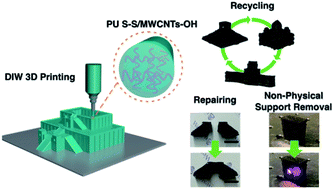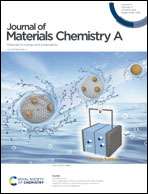Direct ink writing of recyclable and in situ repairable photothermal polyurethane for sustainable 3D printing development†
Abstract
3D printing has attracted considerable attention due to its rapid responsiveness, convenient operation, and high level of personalization. However, the continually increasing waste of printed polymers imposes a heavy burden on the environment, which contradicts the circular economy concept. Herein, a sustainable 3D printing strategy is demonstrated by developing a disulfide-based polyurethane composite and printing via the direct ink writing (DIW) technique. Dynamic disulfide bonds provide the composite with a responsive covalent adaptable network, allowing the material to be printable, repairable and recyclable. The incorporation of hydroxylated multi-walled carbon nanotubes (MWCNTs-OH) enhances the photothermal conversion property to enable precise local heating for repairing. After the sample is cut in half and repaired, the mechanical properties recover to 86.3% after three times NIR laser-triggered in-site repair. Overall, the printed parts feature outstanding recyclability, in situ repairable capability and the ability of contactless removal for supporting structures. This 3D printing strategy possesses great potential to address environmental challenges associated with the waste of 3D printed polymers.

- This article is part of the themed collection: A collection of papers from RSC journals on chemistry and the circular economy


 Please wait while we load your content...
Please wait while we load your content...